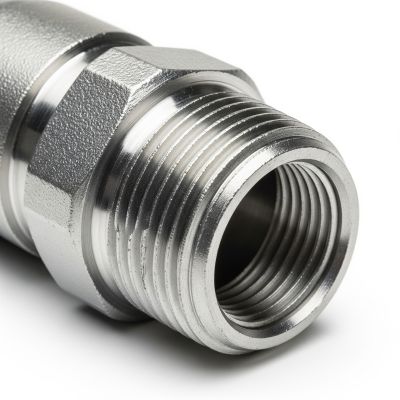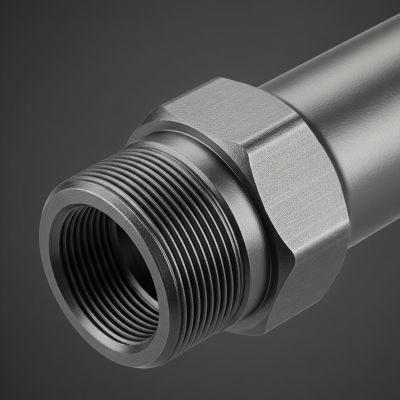Understanding the differences between pipe thread types is crucial for professionals and DIYers alike. Whether you’re working on a home plumbing system or an industrial piping installation, knowing which thread to use can mean the difference between a leak-free fit and a costly failure.
Two of the most commonly confused pipe thread types are NPT (National Pipe Tapered) and IPS (Iron Pipe Straight). While they may appear similar at first glance, these threads have key differences in design, sealing method, and applications.
In this article, we’ll break down the basics of NPT and IPS threads, explore their differences, and help you determine which is right for your next project.
What is NPT (National Pipe Tapered)?
The U.S. standard for tapered threads used on threaded pipes and fittings is called National Pipe Tapered, or NPT. It was created in the 1860s and is still the most widely utilized thread type in North American hydraulic, HVAC, and plumbing systems.
What makes NPT threads unique is their tapered design—meaning the threads become slightly narrower as they go deeper. When tightened, this taper causes the threads to gently distort, forming a mechanical seal that lessens the likelihood of leaks. For an effective seal, thread sealants like PTFE tape or pipe dope are typically used.
Because of this self-sealing nature, NPT threads are ideal for high-pressure systems or applications where leakage is a critical concern, such as gas lines and hydraulic circuits.
What is IPS (Iron Pipe Straight)?
Iron Pipe Straight (or, depending on the situation, Iron Pipe Size) is what IPS stands for. IPS threads are straight (not tapered), which means they don’t tighten progressively like NPT threads do.
Historically, IPS threads were used extensively in old plumbing systems and structural piping, such as handrails or support posts. They rely on mechanical seals—typically gaskets, washers, or O-rings—to prevent leaks. Without these, a straight-threaded IPS connection will not seal under pressure.
While IPS threads are less common in new plumbing systems, they are still used in specific legacy applications and for structural purposes where sealing isn’t the primary concern.
Key Differences Between NPT and IPS
At a glance, NPT and IPS fittings may look the same—but they are not interchangeable. The primary differences come down to thread shape and sealing method:
➡️ NPT threads are tapered, creating a tight seal as they are screwed together.
➡️ IPS threads are straight and require a separate sealing method like a gasket or O-ring.
Using the wrong thread type can result in improper sealing, leaks, or equipment failure—especially under pressure.
Comparison Table: NPT vs IPS
Here’s a comparison between NPT and IPS for better differentiate the two fittings:
|
Feature |
NPT (National Pipe Tapered) |
IPS (Iron Pipe Straight) |
|
Thread Type |
Tapered |
Straight (parallel) |
|
Sealing Method |
Seals via thread deformation + sealant |
Requires washer, O-ring, or gasket |
|
Thread Angle |
60° |
60° |
|
Applications |
Plumbing, hydraulics, pneumatics |
Older plumbing, structural pipe threads |
|
Compatibility |
Not compatible with IPS without adapter |
Not compatible with NPT without adapter |
|
Common Sealant Used |
PTFE tape, pipe dope |
Rubber gasket or compression fitting |
|
Ease of Assembly |
Requires tightening and sealing |
Easier to align and less prone to overtightening |
How to Identify NPT vs IPS Threads
If you’re unsure whether you’re working with NPT or IPS threads, here are some tips for identification:
➡️ Tapered vs. Straight Threads: NPT threads will feel tighter as you screw them in; IPS threads remain uniform.
➡️ Visual Inspection: Tapered threads appear slightly cone-shaped; straight threads look uniform in diameter.
➡️ Use of Thread Gauges: A thread gauge can precisely identify pitch and thread type.
➡️ Manufacturer Markings: Some parts are labeled with NPT or IPS indicators.
Common Mistakes and How to Avoid Them
1. Mismatching Threads
Mixing NPT and IPS threads can cause leaks, stripped threads, or component failure.
2. Over-tightening NPT Connections
Excessive force can damage threads or fittings. Tapered threads seal, not tighten endlessly.
3. Assuming Pipe Diameter Equals Thread Match
Just because two pipes have the same outer diameter doesn’t mean their threads will match. Always verify the thread standard.
When to Use Each Type
➡️ Use NPT for systems involving fluid or gas under pressure, such as water supply lines, air compressors, or hydraulic systems.
➡️ Use IPS in structural applications or to match older systems that already use IPS fittings.
➡️ Consider availability and repair: If you’re working on legacy infrastructure, you may need IPS-compatible parts or adapters.
FAQ Section
Q: Can you adapt NPT to IPS threads?
A: Yes, with special adapters designed to bridge the two thread types. However, this should only be done when absolutely necessary and with proper sealing techniques.
Q: Is IPS still used in modern installations?
A: IPS is less common in new plumbing but still appears in structural pipe systems and some legacy equipment.
Q: What does “IPS” really mean today?
A: “IPS” often refers to the pipe size standard, but in threading contexts, it usually denotes straight threads matching iron pipe sizing.
Conclusion
While NPT and IPS threads may seem similar, they are functionally and structurally different. NPT’s tapered design is perfect for sealed, high-pressure connections, while IPS offers a straight-thread option suited for structural or legacy systems.
Choosing the correct thread type ensures leak-free connections, long-term reliability, and system safety. Always double-check specifications and, when in doubt, consult a professional or use a thread gauge.
Post time: Jun-02-2025



